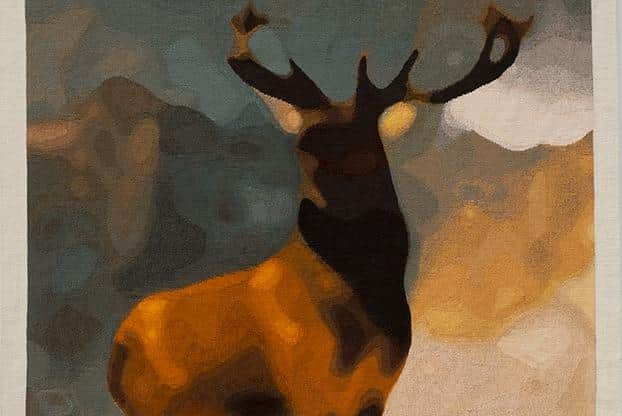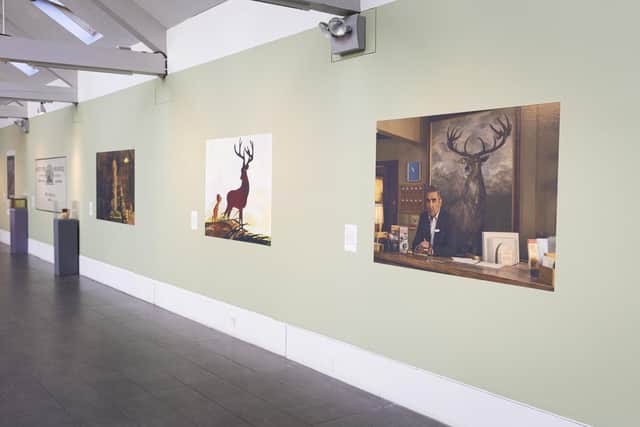Art reviews: Monarchs of the Glen | Making Space - Photographs of Architecture
Monarchs of the Glen: from Whisky to Wes Anderson, Dovecot Studios, Edinburgh ****
Making Space: Photographs of Architecture, Scottish National Portrait Gallery, Edinburgh ****
Advertisement
Hide AdIf you go through the new Scottish wing of the NGS by the expected route from Princes Street Gardens, the last thing you see, the climax of the Scottish display perhaps, before you go up into the old building is Landseer’s Monarch of the Glen. It is a striking image certainly and an exhibition at Dovecot Studios, Monarchs of the Glen: from Whisky to Wes Anderson, traces just how universal it has become, and too how it has appeared and still appears in all sorts of unlikely contexts. Painted in 1851, originally for the House of Lords Refreshment Room in a contract that was cancelled, the painting went through various owners till it was acquired by Thomas Dewar in 1916. It seems to have stayed with the whisky business till it was acquired by the NGS from Diageo in 2013. It was surely a ‘must’ acquisition even if an ambiguous one.


Dewar used his picture to advertise his whisky. More aptly perhaps than he intended. Landseer’s stag is legless, or at least his legs are cut off at the knees. Landseer himself was frequently legless too it seems. He became a serious alcoholic. But even before Dewar’s appropriation of Landseer’s stag, it had already been used in some very odd contexts. Its use as shorthand for Scotland on Scottish shortbread and biscuit tins is fairly obvious perhaps, but its appeal also spread much further afield. It appears, for instance, on a packet of butter from California c1911 and as logo for an Indiana insurance company at much the same time. Later it was incorporated into film. It is suggested here, quite reasonably, that the noble stag in Bambi is based on Landseer’s image. In Moonrise Kingdom by Wes Anderson, it appears improbably against a tartan background in a scoutmaster’s tent, suggesting perhaps a kind ersatz wilderness. It also turns up in a scene in the TV comedy series, Schitt’s Creek, where we are told it is ‘shorthand for a kitsch, every-person aesthetic.’ Although there is a book here with a picture on the cover of the late Queen in robes of the Order of the Thistle standing in an open moorland, the exhibition has missed an even better image. In the film, The Queen, alone on the hills, contemplating the fall-out from Diana’s death, Helen Mirren, as the queen, finds herself face to face with Landseer’s royal stag, two monarchs, one glen. She later meets it gralloched in the Balmoral larder.
For all this, the picture’s conspicuous place in the National Gallery’s new display suggests it is first and foremost a Scottish icon. If so, it should perhaps come with a health warning. Deer have not been good for the country. The mid-nineteenth century when the picture was painted was the age of Balmorality, a time when huge swathes of the Highlands were set aside for ‘sport’, or for the ‘toffs’, in Highland parlance, to shoot things, especially grouse and deer. Landseer joined in enthusiastically and unless they are toffs, people don’t appear much in his paintings.
The degradation of the Highland landscape began long before that however. Around four hundred years ago a concerted effort was made to rid Scotland of wolves. A few isolated individuals may have clung on for a while, but eventually they were exterminated. Deer had free rein. Sheep joined them. The land grazed bare, the forests could not regenerate. We were left with the now familiar landscape of barren mountains. Even now, though, where the deer and sheep are kept out, the forest will regenerate as though nothing had happened.
Among the barren mountains, the glens remained green and that was where the people lived. If the monarch of these glens was a deer, however, clearly his subjects were deer not people. “We’ve cleared the straths/ We’ve cleared the paths/ We’ve cleared the bens/ We’ve cleared the glens/ And we can do it all again/ We’ve got the brass/ We’ve got the class/ We’ve got the law/ We need no more etc.” is a wonderful scrap of toffs’ dialogue from John McGrath’s great satirical play, The Cheviot, the Stag and the Black, Black Oil, displayed in a glass case here. Ross Sinclair is another who challenges the bogus authority of this image. After After After The Monarch of the Glen, Real Life is Dead, is a photograph of the artist looking at Landseer’s picture. Naked to the waist in tartan boxer shorts, he has Real Life is Dead tattooed on his back.


Peter Blake took up the image too. His version is here in reproduction, but he is much less challenging. Peter Savile who reworked Blake’s image with a simplifying filter that, taking away, adds nothing. His version in turn was made into a tapestry by Dovecot. It’s after Landseer, after Peter Blake after Peter Savile, or as it is titled, After After After Landseer. Even if his stag is legless, Landseer’s picture certainly has legs.
Advertisement
Hide AdOn the face of it, an exhibition of photographs of architecture at the Portrait Gallery – Making Space: Photographs of Architecture –has little in common with the still ongoing story of Landseer’s stag, but if you look at the dark side of his image, there are striking photographs here of urban dereliction, a photo by David Peat, for instance, of buildings in Glasgow about to be demolished in 1968, another by Chris Leslie of the explosive charges going off as the Red Road Flats are demolished in 2013, or an apparently neutral but chilling image by Kirsty Mackay of an empty townscape in Drumchapel where buildings once stood. Anticipating these by a century or more, too, are Thomas Annan’s wonderful photos of the slums that were the dark side of Glasgow. All these images do seem to echo the neglect, exploitation and social mismanagement that are the subtext of Landseer’s picture.
There is of course more to this show. Because architecture stands still it was the subject of some of the very earliest photos. In the 1840s, DO Hill and Robert Adamson photographed the building of the Scott moment. In the 1850s, Francis Frith took a camera to Egypt and using huge glass negatives in fearsome conditions produced marvellous photos of the pyramids and the still half-excavated Sphinx. Most of what is here is modern however and some of it is very striking. Colin McPherson and Malcolm Hill both take pictures of of football stadiums, for instance. McPherson focuses on details, while Hill finds images of scale and perhaps even grandeur. Candida Höfer photographs libraries, indeed we are told, the world’s most beautiful libraries although the Madrid library represented here doesn’t really seem to the in quite that class. Most intriguing is a picture of a hotel lobby by Andreas Gursky. The biggest photo in the national collection, it is a wonderful confusion of light and space.
Advertisement
Hide AdMonarchs of the Glen: From Whisky to Wes Anderson, Dovecot Studios, Edinburgh, until 2 March 2024; Making Space: Photographs of Architecture, Scottish National Portrait Gallery, Edinburgh, until 3 March 2024